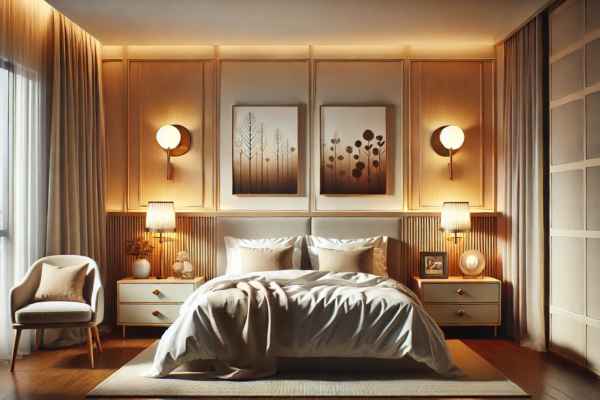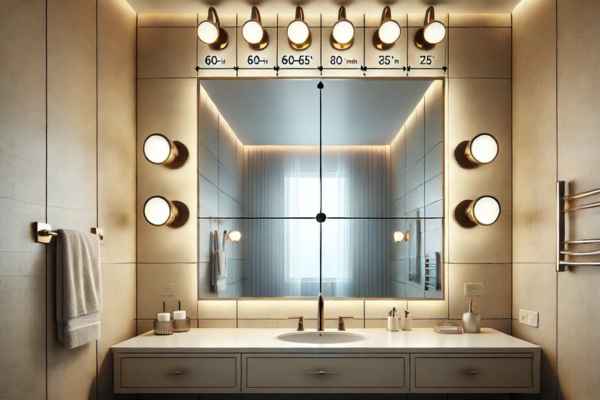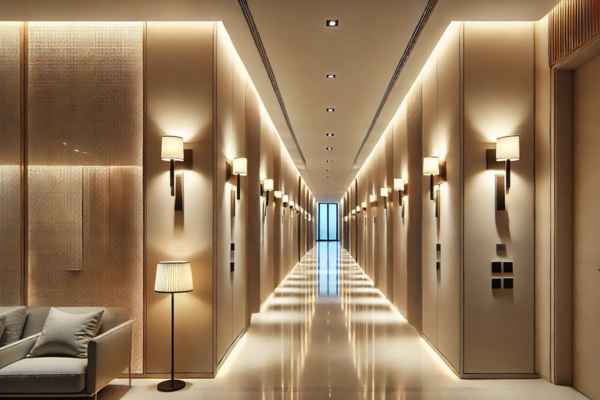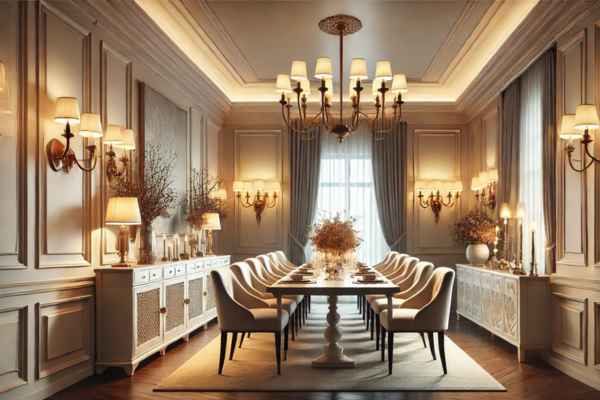Wall sconces are more than just a lighting fixture; they are an artistic element that enhances the ambiance of a room. However, their positioning plays a critical role in achieving the perfect balance of form and function. Hang them too high, and the light may feel disconnected from the space. Too low, and they may interfere with furniture or cast unflattering shadows. The right height ensures optimal illumination and a cohesive aesthetic. This guide explores everything you need to know about how high to hang wall sconce to create an inviting and practical environment in any room.
Understanding Wall Sconces
Wall sconces are mounted light fixtures that provide a blend of accent, ambient, and task lighting. Available in countless styles, finishes, and designs, sconce serve as both decorative and functional elements in interior design. Some sconce direct light upwards, creating a soft glow, while others focus downward for task lighting. Adjustable sconce offer flexibility, making them a versatile lighting solution for various settings. When considering sconce placement, it’s essential to evaluate their purpose. Are they meant to frame a vanity mirror? Provide mood lighting in a cozy reading nook? Or illuminate a long hallway? Identifying the intended function will help determine the ideal height.
The Golden Rule: Standard Height for Wall Sconces
A general guideline for wall sconce placement is to position them between 60 to 72 inches from the floor to the center of the fixture. This range ensures the light remains at an appropriate eye level without overpowering the space. However, this height may vary depending on room function, ceiling height, and furniture placement. A crucial aspect to consider is glare. Placing sconce too high can lead to harsh lighting, while positioning them too low can create uncomfortable brightness in direct sightlines. Following the golden rule helps maintain visual comfort and aesthetic appeal.
Room-by-Room Sconce Height Guide
Different rooms require varied sconce placements based on their function and layout. Below, we break down the ideal sconce height for specific spaces to ensure maximum effectiveness and style.
Living Room Sconce Placement Tips

In a living room, sconce often serve as ambient lighting, enhancing the overall atmosphere. Ideally, sconces should be installed between 60 to 65 inches from the floor, depending on ceiling height and furniture layout.
- If placed above a couch or seating area, position them about 6-12 inches above seated eye level to prevent glare.
- For wall-mounted sconce that act as accent lighting, maintain equal spacing between fixtures for a balanced look.
- If paired with artwork or shelving, sconce should complement the focal point rather than overshadow it.
The Perfect Height for Bedroom Wall Sconces

In a bedroom, wall sconces are commonly used as bedside lighting, either replacing traditional table lamps or complementing existing light sources. The ideal height depends on bed size, mattress height, and personal preferences.
- Above nightstands: Position sconces 24-30 inches above the mattress or approximately 55-65 inches from the floor to allow easy reach for switches.
- Flanking the headboard: When using sconce as reading lights, ensure they are mounted at or slightly above shoulder height when sitting upright in bed.
- Dimmable options: Consider installing dimmable sconce to control brightness levels for reading or relaxation.
Bathroom Vanity Sconces: How High Should They Be?

Bathroom sconces are vital for task lighting, particularly around mirrors and vanity areas. The goal is to provide even, shadow-free illumination for grooming tasks.
- On either side of a mirror: Install sconce at eye level (between 60-65 inches from the floor) to create balanced lighting.
- Above a mirror: If placing a single sconce above the mirror, position it at least 75-80 inches from the floor for optimal overhead illumination.
- Spacing considerations: Ensure sconces are at least 28-36 inches apart to prevent harsh shadows on the face.
Proper placement in bathrooms prevents unflattering lighting and enhances the overall functionality of the space.
Hallways and Entryways: Finding the Right Balance

Hallway sconces provide necessary illumination while adding decorative appeal. Since hallways are passageways, sconce should be positioned to enhance visibility without creating obtrusions.
- Mount sconces between 60-72 inches from the floor, ensuring the light fixture is at or just above eye level.
- Space them 6-8 feet apart for an even distribution of light.
- If ceilings are taller than 9 feet, consider adjusting the placement slightly higher to maintain proportional balance.
Hallway sconce should provide enough light to navigate the space while maintaining a visually pleasing arrangement.
Dining Room Ambiance: Sconce Height Tips

Dining rooms contribute to a warm and inviting atmosphere, often serving as secondary lighting to a chandelier or pendant lights. The ideal placement varies based on wall size and furniture arrangement.
- Position sconces at approximately 65-70 inches from the floor to create soft, ambient lighting.
- When placing them above a sideboard or buffet table, ensure they are at least 24-30 inches above the surface to avoid direct glare.
- Opt for dimmable sconces to adjust the mood depending on the occasion.
Strategically placed dining room sconces add sophistication while enhancing the overall dining experience.
Key Factors to Consider When Determining Sconce Height
When deciding how high to hang wall sconce, several critical factors come into play. First, consider the room’s purpose—a reading nook requires different lighting than a hallway or dining area. Ceiling height also significantly impacts placement; in rooms with higher ceilings, sconce may need to be positioned slightly higher to maintain proportion. Another factor is eye-level placement, often considered the golden rule. Typically, sconce should be mounted between 60-72 inches from the floor, with the light source sitting just above or at eye level to prevent glare. Additionally, consider furniture arrangement. For instance, sconces flanking a bed or sofa should complement the height of these pieces without causing awkward shadows or visual imbalance.
Adjusting Sconce Height for Functionality
While aesthetics are essential, functionality should never be compromised. The intended purpose of the sconce plays a pivotal role in determining its height. For example:
- Task lighting, such as reading sconces in the bedroom, should be positioned lower (around 24-30 inches above the mattress) for easy accessibility and focused illumination.
- Accent lighting for artwork or architectural details may be placed higher to highlight specific features.
- In hallways or staircases, sconces serve primarily as ambient lighting, often installed 66-72 inches from the floor for even distribution.
Adjusting the sconce height based on functionality ensures that the lighting meets practical needs while enhancing the room’s ambiance.
Design Aesthetics and Wall Sconce Placement
Beyond functionality, wall sconces play a significant role in defining a room’s style. Symmetry is a key design principle—when sconces are used in pairs (like flanking a mirror or fireplace), they should be hung at identical heights to create visual harmony. Spacing is equally important. In larger rooms or long hallways, maintain equal distances between sconces to prevent overcrowding. Layering your lighting is another aesthetic strategy. Combine sconces with other light sources like chandeliers, recessed lighting, or floor lamps for a balanced and dynamic environment. Finally, consider the style of the sconce itself. A sleek, modern fixture may look best at a slightly higher placement, while vintage or ornate designs may benefit from being closer to eye level to showcase their details.
Installation Tips for Beginners
If you’re new to installing wall sconces, the process can seem daunting. Start by gathering essential tools: a level, measuring tape, pencil, wall anchors, and a drill.
- Measure carefully: Mark the desired height on the wall, typically between 60-66 inches from the floor for general use.
- Consider wiring: If your wall isn’t pre-wired, you may need professional assistance. For plug-in sconces, ensure proximity to an outlet.
- Use a level: This ensures the sconce sits straight—crooked fixtures can ruin the room’s aesthetic.
- Secure properly: Use the right anchors to support the fixture’s weight, especially if installing on drywall.
Taking your time during installation ensures both safety and style.
Common Sconce Hanging Mistakes and How to Avoid Them
Even experienced decorators can make mistakes when hanging wall sconces. Here are some common pitfalls and how to avoid them:
- Hanging too high or too low: This disrupts the room’s balance. Always refer to the eye-level rule as a baseline.
- Ignoring scale: Oversized sconces in a small room (or vice versa) can overwhelm the space. Choose fixtures proportionate to the wall size.
- Inconsistent spacing: Uneven distances between multiple sconces can make the layout look sloppy. Measure meticulously to maintain symmetry.
- Poor lighting direction: Ensure the light isn’t too harsh or casting unflattering shadows, especially around mirrors.
Being mindful of these mistakes helps create a cohesive, polished look.
Can I Adjust the Height After Installation?
Yes, you can adjust the height of wall sconces after installation, but the process depends on how they’re mounted. Hardwired sconces are more challenging to reposition because they involve electrical wiring hidden within the wall. Adjustments often require patching drywall and re-routing wires, which may need professional help. For plug-in sconces, adjustments are much simpler. You can reposition them without worrying about complex electrical work. Some designs even feature adjustable arms or swivel mechanisms, allowing for easy changes in light direction and height. Planning your placement carefully during the initial installation minimizes the need for adjustments later.
What’s the Best Height for Dimmable Wall Sconces?
Dimmable wall sconces offer flexible lighting options, ideal for spaces where mood control is essential, like bedrooms, dining rooms, or living areas. The best height for dimmable sconces is similar to standard sconce—generally 60-66 inches from the floor to the center of the fixture. However, since dimmable sconce allows for adjustable brightness, they’re more forgiving in terms of placement. You can experiment with slightly higher or lower positions based on the desired effect. For example, in a cozy reading corner, a lower placement might create a more intimate ambiance, while in a hallway, a higher placement can provide broad, diffused lighting.
Should Wall Sconces Match the Height of Other Fixtures?
While there’s no strict rule that wall sconce must match the height of other fixtures, maintaining visual consistency is essential. In rooms with multiple light sources—like a chandelier and sconces—aligning the bottom or center of the sconces with the chandelier’s visual plane can create a cohesive look. However, this isn’t always necessary. For example, bathroom sconces flanking a mirror should be at eye level, even if the overhead light is positioned higher. Similarly, sconce used for accent lighting might be placed higher or lower, depending on the design goal. The key is to ensure the overall arrangement feels balanced, even if the heights differ slightly.
Conclusion
Determining how high to hang wall sconces isn’t just about following rigid measurements—it’s about finding the perfect balance between functionality and aesthetics. While the general guideline is to mount them between 60-72 inches from the floor, factors like room purpose, ceiling height, furniture arrangement, and lighting design all influence the ideal placement. By considering these elements, avoiding common mistakes, and allowing room for adjustments, you can create a space where your wall sconce shine—both literally and figuratively. Whether you’re lighting up a cozy reading nook, framing a bathroom mirror, or enhancing a hallway, well-placed sconces add warmth, style, and character to any room.
